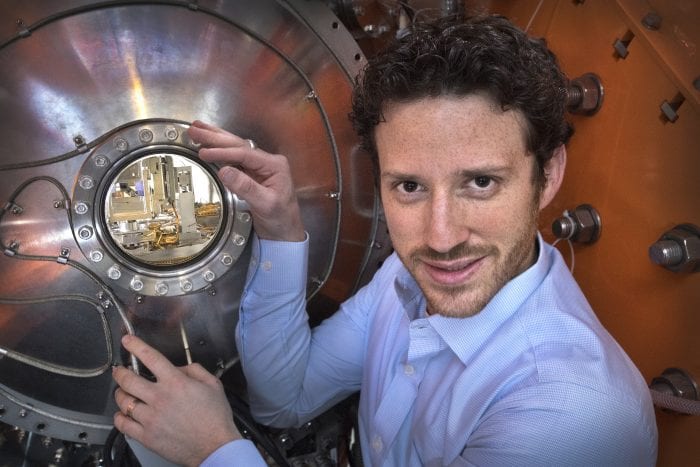By Daniel Dunaief
Like many people who hunch down when they step into cold air, many materials shrink when exposed to the frigid temperatures.
That, however, is not the case for samarium sulfide when it has impurities such as yttrium sprinkled throughout. Indeed, the material goes through negative thermal expansion, in which cold air causes it to expand.
Daniel Mazzone, a post-doctoral fellow in Brookhaven National Laboratory’s Condensed Matter Physics and Materials Science Department who is joining the Paul Scherrer Institute in May, wanted to know how this happened.
Working with synchrotrons on three different continents, at the National Synchrotron Lightsource II at BNL, the Soleil synchrotron in France and the SPring-8 synchrotron in Japan, Mazzone and a team of scientists explored the properties of this metal.
The work that led to an understanding of the properties that made the metal expand in cold temperatures could have applications in a range of industries. Some companies use materials that balance between expansion and contraction to prevent the lower temperatures from altering their configuration.
Mazzone said the expansion properties can be fine tuned by altering the mixture of materials. With these results, he and his colleagues “bring a new material class to the focus of the community,” he wrote in a recent email.
So, what is happening with this samarium sulfide mixed with yttrium particles?
In a paper in the journal Physics Review Letters, Mazzone and his partners, including Ignace Jarrige, who is the group leader of the Soft Inelastic X-ray Scattering Beamline, described the way mobile conduction electrons screen the samarium ions, causing a fractional transfer of an electron into the outermost electronic samarium shell. Quantum mechanical rules govern the process.
Using the Pair Distribution Function beamline at NSLS-II, the researchers performed diffraction experiments. The scientists determined how the x-rays bounced off the samarium sample at different temperatures. The sample was contained in a liquid helium cooled crysotat.
“We track how the x-rays bounce off the sample to identify the locations of atoms and the distances between them,” Milinda Abeykoon, the lead scientist of the PDF beamline, said in a press release. “Our results show that, as the temperature drops, the atoms of this material move farther apart, causing the entire material to expand up to three percent in volume.”
In France and Japan, the researchers also used x-rays to explore what electrons were doing as temperatures changed.
“These ‘x-ray absorption spectroscopy’ experiments can track whether electrons are moving into or out of the outermost ‘shell’ of electrons around the samarium atoms,” Jarrige explained in a press release.
The valence electrons in samarium, which are the outermost electrons, are in a shell that is under half full. That means that they are more reactive than they would be if they the shell was full, as it is with noble gases.
The researchers observed that a fractional part of the electrons are transferred from the conduction band in the outermost samarium shell. This causes the samarium to expand, as the outermost shell needs to accommodate an extra electron. When this happens for the numerous ions in the system, this can have an important effect.
By working with Maxim Dzero, who is a theoretical physicist at Kent State University, the scientists were able to apply the Kondo effect, which was named after solid-state physicist Jun Kondo. Back in the 1960s, Kondo explained how magnetic impurities encourage electron scattering at low temperatures, which not only increases the volume of the materials, but can also increase their electrical resistance.
In the Kondo effect, electrons align their spins in the opposite direction of the larger magnetic articles to cancel its magnetism. For the samarium material, the outer shell moves around the atomic core, creating the magnetic moment of the samarium ion.
“For some elements, because of the way the outer shell fills up, it is more energetically favorable for electrons to move out of the shell,” Jarrige explained in a press release. “But for a couple of these materials, the electrons can move in, which leads to expansion.”
A phone call among several of the collaborators led them to believe the process involved with the samarium was akin to the one that causes water to expand when it freezes. As scientists build on this understanding, they will likely need to create or search for similar but alternative materials to samarium sulfide, Mazzone said.
Samarium sulfide is incredibly expensive. Materials scientist will need to find the right elements that can “do the same job,” he explained. “The next step is to find the materials that are cheaper and optimize it.”
Mazzone, who is currently living in his home country of Switzerland, is preparing for his next job, which is expected to start next month.
He and his wife Fabienne, who is an economist at the ski producer Stöckli, enjoyed living on Long Island during his two year post-doctoral research experience.
“Switzerland is landlocked and surrounded by mountains,” said Mazzone, who speaks German, French, English and some Italian. “Having a beach at the front door [when they lived on Long Island] was beautiful.”
Dedicated climbers, the Mazzones traveled to the Shawangunk and Adirondack mountains while they lived on Long Island to find an outlet for their passion for rock climbing.
As for his future work, Mazzone anticipates remaining in academia where he would like to continue his research and teach. He plans to conduct additional experiments on the Kondo effect. These materials also feature properties such as unconventional superconductivity and other quantum phases that may help with quantum computing.





